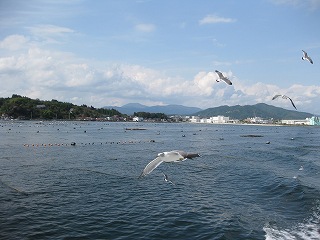PARC TOP>オーディオ・ビジュアル>作品詳細
Finding Connections; Sea, Forest and Our Lives

The Pacific Asia Resource Center (PARC), a Japanese NGO that has been working since the 1970’s on issues including development and fair trade in the Asian region, is pleased to announce the release of its newest DVD, “Finding Connections; Sea, Forest and Our Lives”. The video was released with the intent of promoting sustainable development and biodiversity conservation in Japan and abroad ― particularly in rapidly developing Asian countries.
Recently, in the name of modern development, human actions have been destroying increasingly large swathes of the natural system on which we depend for food production and the continuation of life itself. The video features interviews with people who defy this trend by continuing to live in harmony with nature often against overwhelming forces. By listening directly to their experiences, we gain a valuable opportunity to learn more about the connections between humans and nature as well as between the workings of nature and ourselves.
The ways that human beings relate to nature reflects the values of the time. Around the 1960s, Japan’s oceans, rivers, forests and fields underwent major changes as the country attempted to double its national income by exporting industrial products. At this time, productivity and efficiency ruled the sea, forest and fields. The environmental damage was staggering:
- Coastal tidal flats, which are precious habitats for various aquatic species that sustain the food chain of the sea, were destroyed as shores were reclaimed to build industrial plants.
- The flow of rivers, which bring rich nutrition from mountains to the sea, was interrupted by dams built to generate electricity, prevent floods, and create reservoirs to meet the projected increase of industrial and domestic water demand.
- Broad-leafed trees, the natural vegetation of the Japanese archipelago, were replaced with conifers in order to meet growing demand for wood, which later began to face fierce competition from imports.
- Planted conifer trees were left abandoned, and their reduced water- holding capacity resulted in floods and landslides.
- Chemical fertilizers and pesticides were also introduced to agricultural fields through which rivers and oceans flowed.
The video also features a series of inspiring interviews with the following individuals, who have dedicated their lives to sustaining various natural systems in the face of such destruction:
- Kudoh Kohta (Furniture artisan, Representative Director of Iwaizumi Pure-wood Funiture)
- Kumagai Hiroyuki (Forestry and Agriculture, Former Executive Director of the Campaign Coalition Against the Niitsuki Dam)
- Hatakeyama Shigeatsu (Oyster Farmer, Representive Director of Mizuyama Sea Farm)
- Ohno Kazutoshi (Fishery, President of Funabashi City Fishery Cooperative)
- Onodera Hiroshi (Agriculture)
“All living things are protected by the environment and the earth...humans are just one of these species.”
Maintains a strong philosophy that trees must be used in a sustainable way by taking into consideration the pace of forest regeneration. Runs a furniture work shop via the concept of “Making furniture that last for 300 years with trees that have lived for 300 years.”
“We’ll never get back those 27 years. We spent blood and sweat, but now we have peace of mind. We preserved the foundation of our livelihoods.”
Lead the campaign coalition against a local dam project for almost three decades. Conducted relentless civil research and promotion until the project was finally frozen in 1997, and was also elected as a local city council member.
“It’s important to raise awareness among people living in the river basin.”
Fisher who planted broad-leaf trees along upstream mountains along a river slated for a dam project, in order to let people know that rivers are vital sources of nutrition for the blessings of the ocean. This movement, named “The Forest Is the Sweetheart of the Sea,” gathered widespread attention.
“Rivers flowing into Tokyo Bay were once full of aquatic species. Tokyo Bay and its tidal flats were also habitats for various marine species. But human beings destroyed these habitats. They didn’t do so on purpose, but out of ignorance.”
Fisher who has lived on Tokyo Bay for over 60 years carrying out his family’s fishing business, whose tradition may be traced back to the 17th century. He contributed to the conservation of Sanbanze, an 1800-hectare tidal flat remaining in Tokyo Bay, emphasizing its importance for the fishery.
“With wet rice paddies, you can harvest a certain amount of rice without fertilizer, since the water from forests is rich in nutrients.”
Farmer living upstream of the basin who joined “The Forest Is the Sweetheart of the Sea” movement, thereby becoming inspired to stop raising broiler chickens and become an organic farmer.
With natural resources rapidly disappearing throughout the world in the present day, we believe that the Japanese experience can help us reconsider the concept of “development” itself thereby helping us to relearn what we’ve lost. It is our hope that more people will then make the choice to begin returning to natural, sustainable lifestyles.
- DVD (NTSC / PAL)/35min
- Bilingual (Japanese/English)
- Price $20 for developing countries, $60 for developed countries ※5% tax and the shipping cost is not included
- “Finding Connections; Sea, Forest and Our Lives” Chapter 1: Natured Changed by People
Humans and Nature in the Modern Era
Reclaimed Tidal Wetlands and the Impoverished Sea
Chapter2: Severed Connections
The Agricultural Basic Law and the National Income-Doubling plan
Extensive Forestation and Increased Timber Imports
Chapter3: The Roles of the Forests and Rivers
The Soil and Water Holding Capacity of Mountains
Proliferating Dams
Connecting the Mountains and the Sea
Awareness Changed Reality
Harnessing Nature in the Mountains
Chapter4: Interconnected Lives
Culture of Broad-leaf Forests
Sanbanze, a Fishing Ground in Northern Tokyo Bay
Values behind Choices
- To purchase or for further information, please kindly contact us. Tel: +81-3-5209-3455 Mail: video@parc-jp.org
